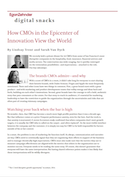How CMOs in the Epicenter of Innovation View the World
We recently held a private dinner for 20 CMOs from some of San Francisco’s most disruptive companies in the hospitality, food, insurance, financial services and media sectors. The conversation was wide-ranging, but it quickly converged on the tremendous possibilities—and expectations— attached to the role.
Our key takeaways:
The brands CMOs admire—and why
With a score of CMOs in a room, it didn’t take long for everyone to start sharing their favorite brands, with Under Armour, Virgin and Apple the most frequently mentioned. These and other icons have two things in common. First, a great brand starts with a great product—and with marketing and product development teams that volley energy and ideas back and forth, building on each other’s innovations. Second, great brands have the courage to tell a bold, authentic story that puts consumers at the center. For that story to reach its audience, it’s essential for marketing leadership to have the conviction to guide the organization through the uncertainties and risks that are often part of creating visionary campaigns.
Watching your back when the bar is high
No wonder, then, that CMO has become a much more high-profile position than it was a decade ago. But that influence comes at a price: Frequent performance anxiety, even for the best. And the truth is, that anxiety is warranted. A recent Accenture study confirmed that when companies don’t meet growth targets, it is usually the CMO who is called on the carpet—and often replaced¹. As the most visible interface between the company and the customer, it is simply too easy for CMO to be held responsible for factors outside of his or her control.
In a sense, the problem is one of marketing the function itself. As always, communication and narrative are key. CMOs need to continually signal that they are organizing their efforts in support of the business and to manage chronically high expectations. CMOs must also make sure that the metrics they use to measure campaign effectiveness are aligned with the metrics that others in the organization use to monitor success. Everyone needs to be reading the same story. Of course, this doesn’t guarantee that everyone will have the same interpretation. But having shared reference points makes it less likely that those interpretations will be wildly divergent.
1“The C-level disruptive growth opportunity,” Accenture, 2016.
Digital isn’t everything
Thriving under high expectations also means using every tool at your disposal. So while digital has driven massive change throughout the marketing function, the CMOs at our dinner haven’t forgotten that there are other arrows in the quiver. The CMOs of two insurance disruptors—in tech-obsessed San Francisco, no less—talked about the role direct mail plays in their omni-channel strategies targeting both millennial and mature audiences.
When great brands change hands
Our dinner started with a discussion of great brands; it ended with speculation on their future. Virgin, after all, is now owned by Alaska Airlines; Starwood was acquired by Marriott. What happens when experience-driven, go-go brands are acquired by more conservative, operations-focused enterprises? As the integrations unfold, will Virgin and W continue to inspire the same emotional response that made them icons, while benefitting from behind-the-scenes operational excellence? Or will the distinctive edges of these brands be allowed to gradually wear away—if not disappear entirely? How this question is answered will help determine the next set of challenges and opportunities CMOs will face.







